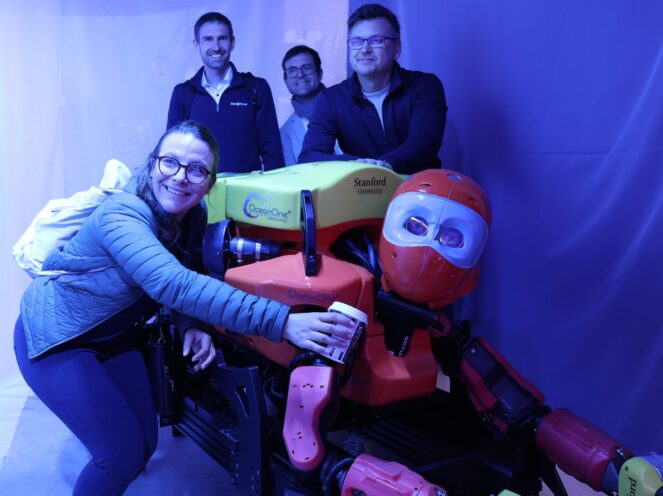
San Francisco – March 21, 2025
Written by Fabienne Kiener, PhD, Relationship Manager at IPZ (Innovation Park Zurich)
Although the metaphor of bridges may be overused, it perfectly fits the insights into international innovation ecosystems. Plus, the Golden Gate Bridge is San Francisco’s defining landmark.
Swissnex in San Francisco and Switzerland Innovation Park Zurich (IPZ) share a common mission: building bridges between academia and industry to accelerate innovation. Swissnex in San Francisco focuses on connecting Switzerland and the US West Coast, while IPZ fosters a community of international innovators within its physical park in Zurich, creating a platform with ETH Zurich, the University of Zurich, EMPA, startups, and R&D units of established companies. Its focus areas include Robotics & Mobility, Space & Aviation, and Advanced Manufacturing & Materials. I, Fabienne Kiener, PhD, Relationship Manager at IPZ, joined a tailor-made residency program at Swissnex in San Francisco, focusing on robotics to attract new partners, with the ultimate goal of attracting companies’ R&D units to establish themselves at IPZ.
On a personal level, I love exploring the connections between academia and industry. I often refer to “my previous academic life,” reflecting on my years as a management and economics researcher at the University of Zurich. Now, working in the innovation industry, I find it incredibly inspiring to bridge those two worlds while continuously learning, especially about engineering fields like robotics.
But enough about me, here I share some of the insights I gained during my residency program at Swissnex in San Francisco:
Connecting innovation ecosystems internationally: A contradiction?
Think of Silicon Valley as the quintessential example of an innovation ecosystem. Most of us can easily name its key players—leading academic institutions like Stanford University and UC Berkeley, numerous startups and tech giants such as Apple, Google, OpenAI, and Hewlett-Packard (HP), as well as prominent venture capital firms (e.g., Sequoia Capital)—all of which are deeply embedded in the region. The dynamic interplay between these actors, along with essential resources (e.g., funding) and frameworks (e.g., regulations), contributes to the global hub for innovation that Silicon Valley represents. It’s no coincidence that Swissnex has established a strong presence in San Francisco.
Localization is a typical feature of most innovation ecosystems. Physical proximity facilitates collaboration, accelerates knowledge transfer, and creates a rich talent pool, and Silicon Valley’s specific geographical region is no exception.
The concept of an innovation park is built on this idea: creating a center of gravity where key players come together. Research on regional innovation ecosystems is extensive, and I recommend reading the work of my former colleagues at the University of Zurich and the Swiss Leading House VPET-ECON.
Since starting my role at IPZ, focusing on international activities, one question has constantly been on my mind: Given the importance of physical proximity, is it a contradiction to aim for international connections when building innovation ecosystems?
I don’t see it as a contradiction but rather a matter of perspective. When approaching this question, I focused on the key ingredient: people. They are at the heart of the innovation ecosystems, connected to each other, and able to explain the local landscape. Take my collaboration with Swissnex in San Francisco as an example—while I have (some) expertise in Zurich’s local ecosystem, the team in San Francisco has the network and connections with industry leaders, academic institutions, and other key experts in the Bay Area.
Swissnex played a crucial role in identifying key players in robotics, establishing connections, and facilitating meaningful conversations. Most importantly, they helped me navigate and understand the local business culture and mindset.
Sarah Burckhardt, Academic Engagement Program Manager at Swissnex in San Francisco—who accompanied me nearly every step of the way—and I discussed each meeting in detail. We analyzed them through the lens of business culture, especially considering differences in interpersonal interactions between the US West Coast and Switzerland. A typical example of a discussion about interpersonal interactions was that I sometimes struggled to gauge my counterparts’ level of enthusiasm. While my work is quite international, and I spent several months in the US, I am aware that my perception of excitement differs from the Bay Area’s norm. What felt like super high enthusiasm to me is average there. A better understanding of these differences helped me build meaningful connections with people in the Bay Area.
My conclusion: Building bridges between global innovation ecosystems is possible and necessary. The key is connecting people while leveraging local expertise.
Content matters! Robotics as a combination of hardware and software
Focus areas and topic clusters are essential for thriving innovation ecosystems because they bring together actors facing similar challenges. When comparing Zurich and the Bay Area, robotics stands out as a natural industry vertical. Greater Zurich Area often uses the phrase “Silicon Valley of Robotics” to describe Switzerland and Zurich in particular.
But robotics is too broad. A closer look reveals Zurich’s strength in robotics, particularly in integrating hardware and software, exemplified by ETH spin-offs ANYbotics and Ascento. Attending several Hardware Meetups in Zurich has given me valuable insights into hardware developers’ challenges. For instance, development requires more funding and a longer timeline than software. Additionally, since manufacturing processes vary significantly across development phases, scaling from prototype to mass production presents a significant challenge. As an economist by training, I may not grasp every technical detail, but understanding these unique challenges is crucial for my role. Moreover, these challenges can vary globally, and gaining deeper insights allows me to articulate better the added value of partnering with our innovation park.
Before starting the cooperation with Swissnex in San Francisco, I wondered: Is the Bay Area solely focused on AI without any hardware component? Not quite. Through in-depth research, Swissnex in San Francisco identified key players like OMRON and Autodesk Research, both combining software and hardware. This combination requires employees with both theoretical and applied skills. Our innovation park offers talent that went through project-based training, which takes place at the ETH Hangar at our innovation park.
How I experience topics: Physical AI and skills
Some topics tend to surface across different contexts, as illustrated by my experience with physical AI—physical systems capable of performing tasks typically associated with intelligent organisms. During my residency, this topic came up repeatedly, from conversations with robotics experts in the Bay Area to encountering ETH spin-off Mimic, one of the Startup Camp (Robotics) participants powered by Innosuisse and managed by Swissnex. Mimic tackles the embodiment gap between humans and robots, exemplifying physical AI, a combination of a hardware component with human-based training—leveraging an “intelligent organism” to enhance robotic learning.
During my time in the Bay Area, I was reminded of several conversations in Zurich with Prof. Mirko Kovac (EMPA) about physical AI. In the paper “Skills for Physical Artificial Intelligence,” the authors outline the essential skills and interdisciplinary knowledge needed to advance physical AI. They argue that physical AI requires new skills for researchers beyond what was previously required in robotics (e.g., mechanical engineering). This new set of skills includes knowledge of biological systems and material science, which are crucial for leveraging insights from intelligent organisms—the foundation of physical AI.
Given that skill sets were a key focus of my thesis, I was immediately intrigued. In my previous academic life, I studied different skill sets—such as noncognitive skills (e.g., social skills)—which are becoming increasingly important due to technological progress, leading to increased teamwork.
But before getting lost in the depths of my dissertation, I want to return to an insight into something I believe Swissnex in San Francisco did exceptionally well.
A Lesson Learned: Synergies, Synergies, Synergies
Synergies are at the core of how Swissnex in San Francisco operates. During my residency, other programs and events focusing on robotics happened, not by miracle, but by intention. Thanks to this approach, I had the opportunity to attend and participate in additional activities:
- A Startup Camp focused on robotics took place during my residency, which was a perfect thematic fit. I had the opportunity to attend a fantastic pitch night featuring four Swiss startups and join them in visiting the Stanford Robotics Center, where we met OceanOneK, which operates without innovation fuel (i.e., coffee) (see photo).
- Swissnex and INSEAD co-organized a panel discussion on the future of space robotics. During the discussion, the moderator, Emilia Pasquier, CEO of Swissnex in San Francisco, asked the panel experts an intriguing question, “Are robots better suited for life in space than humans?”
- San Francisco offers more than conventional transport options. Sarah Burckhardt, the Academic Engagement Program Manager at Swissnex in San Francisco, and I had the opportunity to experience this fully autonomous vehicle, Waymo (see photo). Navigating the city without a human driver was surreal and exhilarating at the same time.
These synergies gave me even more inspiration and valuable connections. I also put the approach of building synergies into practice: Through Swissnex in San Francisco, I had the opportunity to meet Andra Keay, Managing Director of Silicon Valley Robotics, twice during my time there. She is also the founder of Women in Robotics, a fantastic bottom-up network with a Zurich chapter established last year. It was a pleasure to pass along greetings from Zurich— a truly valued synergy.
A Mindset Experience: Paying It Forward
From my first day in the Bay Area, when Corine Thommen, Deputy CEO & Head of Programs at Swissnex in San Francisco, introduced me to the “paying it forward” mindset, to today, this culture of proactively helping others without expecting immediate returns has followed me.
One meeting often leads to three more, as people readily introduce and recommend others. The ripple effect of generosity and collaboration is truly remarkable. The mindset is hard to describe; it has to be experienced.
To conclude, I’ve encountered countless metaphorical bridges, whether between academia and industry or between international innovation ecosystems. While I may lose track of them all, I’m sure many more are ahead, and in the meantime, I warmly encourage you to join Swissnex in San Francisco and create your own Silicon Valley experience.
Written by Fabienne Kiener, PhD, Relationship Manager at Innovation Park Zurich, and edited by Gwenaëlle Gisiger, Communications Associate at Swissnex in San Francisco.


